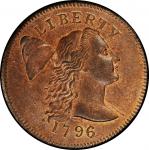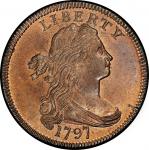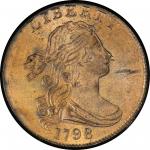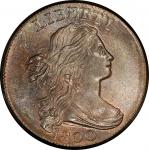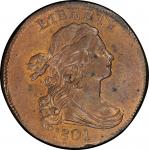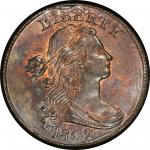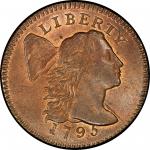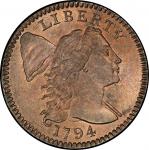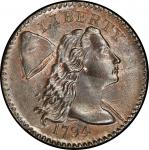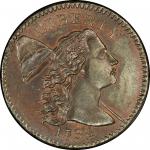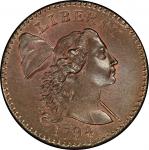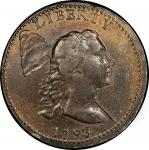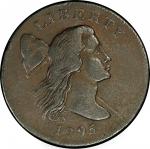The said memorialist again called on the committee on his own accord, and informed them that his press was ready, that he had made dies also, and would prove by actual experiment what he had asserted as theory. - Elias Boudinot, Report of the Memorial of John Harper, February 8, 1796Earthen olive and steel with surfaces that display fine granularity, this historic Jefferson Head cent was undoubtedly found in the soil before George F. Seavey added it to his legendary collection in 1865. The design elements show good uniform detail, particularly bold within the distinctive portrait for which this variety has become rightly famous. The surfaces, though not smooth, are even and attractive, offering good contrast to the devices they support. A batch of old parallel scratches is present against the top of Libertys head, and an old scrape hides within the open base of the cap. A very light rim bruise is well hidden behind the caps tip.The most worn cent in the D. Brent Pogue Collection is also perhaps the most interesting, coined outside the United State Mint by John Harper in an attempt to win a private coining contract. Harpers name is well known to numismatists, as his humble saw shop (sometimes mistakenly called a "cellar") is thought to have been the facility where the 1792 half dismes were struck, standing in for the still-unfinished United States Mint nearby.Harpers shop, where this coin was struck, was on the northeast corner of North 6th and Cherry Streets, a stones throw from President Washingtons house at 5th and Market and within sight of Independence Hall; the site is now occupied by the National Constitution Center. The First Philadelphia Mint was a little over a block away on 7th Street. Harpers proximity and skill set made him a natural partner for the Mint, and he turns up several times in the Mints account books: providing a press and mechanical assistance in 1792, selling saws in 1793, and selling a pair of rollers in 1794. Harpers talents as a blacksmith and machinist were well known to the Mint when Elias Boudinot, then a congressman, sought advice from Mint assayer Albion Cox on how to improve the Mints processes and production. Cox took "the liberty of recommending to you a practical man who operated in the New Jersey coppers - he will give you such information with respect to the proceedings of coinage as will appear almost incredible when contrasted with the present proceedings." Assuming that Boudinot, then in the midst of an inquisition into the Mints operations on behalf of Congress, must "be acquainted with the defects" of that institution, Cox strongly recommended he talked to "John Harper, now very extensively in the saw-making business near the iron works at Trenton."According to a forthcoming book by Leonard Augsburger, Joel Orosz, and Pete Smith, Harper "visited the Mint on January 23, 1795, and suggested improvements but [David] Rittenhouse and the staff of the Mint were not impressive." Rittenhouse resigned the following June, followed in the directors office by Henry deSaussure, who lasted until just October. The next Mint Director was Elias Boudinot, who had been hearing about Harper for nearly a year by that point.Harper reached out to Boudinot almost immediately after his appointment. He wrote on November 4, 1795:I propose to engage with you ... to receive sheet copper of the right size and coin the same into cents complete for circulation at the rate of eighty dollars per ton and to return the same in cents and shruf deducting twenty-five pounds in each ton for waste. I will also forge and harden all the dies, beds, and punches for the same.Recognizing that promises and actions are two different things, Harper showed Boudinot what he could do. He made dies and struck the coins that we today call Jefferson Head cents. Elias Boudinot dutifully reported to Congress on Harpers work on February 3, 1796. He told the House of Representatives that Harper had "with great candor and freedom communicated his knowledge" but, having felt a cold reception by the current staff at the Mint during his interaction with them, decided to "make a press and cutting machine at his own expense." A few weeks later, Boudinot reported, Harper"Informed them that his press was ready, that he had made dies also, and would prove by actual experiment what he had asserted as theory. The committee attended, and were greatly pleased with the simplicity of the machine, and the expedition with which it struck the coins. The committee from their own pockets reimbursed the memorialist [i.e. Harper] for the copper he had used in the experiment, and recommended him to the Secretary of State for further attention."It made Boudinot nervous that Harper had dies that looked so much like Federal cents, so he informed Congress that when he "found the dies used by the memorialist [Harper] still in his possession and conceiving this to be very improper [he] took them into the Mint." When he realized that he had no power to reimburse Harper for the dies or his other labors, Boudinot offered him a job as assistant coiner. Harper declined.Within 70 years, Harpers cents were valuable collectibles. The earliest acknowledgement of the desirability of the "Jefferson Head" cents appears in W. Elliot Woodwards sale of October 1864, where lot 617 was described as "1795 Sometimes called the Jefferson Head, in rather poor condition but an extremely rare type." William Strobridge, a coin dealer then based in New York, bought it for one dollar. The coin offered here appeared in Woodwards very next sale as lot 1811. Woodward called it "unquestionably the finest example of this cent known; the hair is slightly rubbed but the piece is scarcely in any degree injured by circulation. In this condition, the 1795 cent of this variety is by far the rarest of the series, the 1799 being common by comparison." It brought $9.50, an enormous advance over the lower quality example Woodward sold a few months before. The buyer, George A. Seavey, was William Strobridges best client; in 1873, Strobridge acted as the middleman when Parmelee bought Seaveys extraordinary collection intact.It is unknown when this variety was first identified as distinctive, or given the name "Jefferson Head," or by whom. The earliest reference your cataloger can trace is Ed Cogans sale of June 1864, where one was listed under the heading of "Fabrications," along with things like Bolen copies and pieces with altered dates. Described as "1795 Cent, Jefferson Head," it sold for a quarter. If Cogan could simply call it a "Jefferson Head" and assume bidders would know what it was, and Woodward could use the same name just a few months later, the moniker must have had general currency by then.By the 20th century, the Jefferson Head was revered as a distinctive rarity in the early date series. First dismissed as a counterfeit intended for circulation, Walter Breen appears to have been the first to make the connection between these cents and John Harpers experiment, leading modern collectors to appreciate these coins and not only rarities, but historical relics of the Mints unsteady infancy. Nearly all surviving specimens are heavily circulated, and many are damaged. Three varieties are known: Sheldon-80, as here, with a plain edge; 1795 NC-1, with a different reverse die and a lettered edge; and 1795 NC-4, from the same dies as Sheldon-80 but with a lettered edge. Among the three varieties, not a single example exceeds Very Fine. This one is listed as sixth finest in the Breen/Bland census, and tied for seventh on the most recent Noyes census. It exceeds every known example in the length of its provenance, however, extending without break to 1865.

